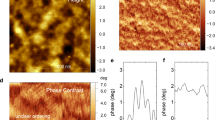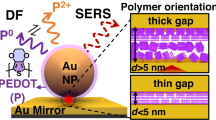Abstract
Conjugated polymers find applications in a range of devices such as light-emitting diodes, field-effect transistors and solar cells. The elementary electronic response of these semiconductors to electric fields is understood in terms of nanoscale perturbations of charge density. We demonstrate a general breaking of spatial charge symmetry by considering the linear Stark effect in the emission of single chromophores on individual chains. Spectral shifts of several nanometres occur due to effective dipoles exceeding 10 D. Although the electric field does not ionize the exciton, some molecules exhibit field-induced intensity modulations. This quenching illustrates the equivalence of charge symmetry breaking and polaron-pair or charge-transfer-state formation, and provides a microscopic picture of permanent charging, which leads to doping and exciton dissociation in actual devices. In addition to using this tuneable emission in single-photon electro-optic modulators, hysteresis in the Stark shift suggests a route to designing nanoscale memory elements such as molecular switches.
This is a preview of subscription content, access via your institution
Access options
Subscribe to this journal
Receive 12 print issues and online access
$259.00 per year
only $21.58 per issue
Buy this article
- Purchase on Springer Link
- Instant access to full article PDF
Prices may be subject to local taxes which are calculated during checkout





Similar content being viewed by others
References
Malliaras, G. & Friend, R. An organic electronics primer. Phys. Today 58, 53–58 (2005).
Forrest, S. R. The path to ubiquitous and low-cost organic electronic appliances on plastic. Nature 428, 911–918 (2004).
Hagler, T. W., Pakbaz, K. & Heeger, A. J. Polarized-electroabsorption spectroscopy of a soluble derivative of poly(p-phenylenevinylene) oriented by gel processing in polyethylene-polarization anisotropy, the off-axis dipole-moment, and excited-state delocalization. Phys. Rev. B 49, 10968–10975 (1994).
Weiser, G. Stark-effect of one-dimensional Wannier excitons in polydiacetylene single-crystals. Phys. Rev. B 45, 14076–14085 (1992).
Schindler, F., Lupton, J. M., Feldmann, J. & Scherf, U. A universal picture of chromophores in pi-conjugated polymers derived from single-molecule spectroscopy. Proc. Natl Acad. Sci. USA 101, 14695–14700 (2004).
Schwartz, B. J. Conjugated polymers as molecular materials: How chain conformation and film morphology influence energy transfer and interchain interactions. Annu. Rev. Phys. Chem. 54, 141–172 (2003).
Pope, M. & Swenberg, C. E. Electronic Processes in Organic Crystals and Polymers 2nd edn (Oxford Univ. Press, Oxford, 1999).
Moerner, W. E. & Orrit, M. Illuminating single molecules in condensed matter. Science 283, 1670–1676 (1999).
VandenBout, D. A. et al. Discrete intensity jumps and intramolecular electronic energy transfer in the spectroscopy of single conjugated polymer molecules. Science 277, 1074–1077 (1997).
Huser, T., Yan, M. & Rothberg, L. J. Single chain spectroscopy of conformational dependence of conjugated polymer photophysics. Proc. Natl Acad. Sci. USA 97, 11187–11191 (2000).
Müller, J. G. et al. Linewidth-limited energy transfer in single conjugated polymer molecules. Phys. Rev. Lett. 91, 267403 (2003).
Schindler, F. & Lupton, J. M. Single chromophore spectroscopy of MEH-PPV: Homing-in on the elementary emissive species in conjugated polymers. ChemPhysChem 6, 926–934 (2005).
Becker, K. & Lupton, J. M. Dual species emission from single polyfluorene molecules: Signatures of stress-induced planarization of single polymer chains. J. Am. Chem. Soc. 127, 7306–7307 (2005).
Schindler, F. et al. Counting chromophores in conjugated polymers. Angew. Chem. Int. Edn 44, 1520–1525 (2005).
Müller, J. G., Lupton, J. M., Feldmann, J., Lemmer, U. & Scherf, U. Ultrafast intramolecular energy transfer in single conjugated polymer chains probed by polarized single chromophore spectroscopy. Appl. Phys. Lett. 84, 1183–1185 (2004).
Rohlfing, F. & Bradley, D. D. C. Non-linear Stark effect in polyazomethine and poly(p-phenylene-vinylene): The interconnection of chemical and electronic structure. Chem. Phys. 227, 133–151 (1998).
Liess, M. et al. Electroabsorption spectroscopy of luminescent and nonluminescent pi-conjugated polymers. Phys. Rev. B 56, 15712–15724 (1997).
Weiser, G. Comparative electroabsorption studies of organic and inorganic solids. J. Lumin. 110, 189–199 (2004).
Gelinck, G. H. et al. Measuring the size of excitons on isolated phenylene-vinylene chains: From dimers to polymers. Phys. Rev. B 62, 1489–1491 (2000).
Harrison, M. G. et al. Electro-optical studies of a soluble conjugated polymer with particularly low intrachain disorder. Phys. Rev. B 60, 8650–8658 (1999).
Chin, B.-C., Misawa, K., Masuda, T. & Kobayashi, T. Large static dipole moment in substituted polyacetylenes obtained by electroabsorption. Chem. Phys. Lett. 318, 499–504 (2000).
Leng, J. M. et al. Optical probes of excited-states in poly(p-phenylenevinylene). Phys. Rev. Lett. 72, 156–159 (1994).
Orrit, M., Bernard, J., Zumbusch, A. & Personov, R. I. Stark effect on single molecules in a polymer matrix. Chem. Phys. Lett. 196, 595–600 (1992).
Wild, U. P., Güttler, F., Pirotta, M. & Renn, A. Single molecule spectroscopy—Stark-effect of pentacene in para-terphenyl. Chem. Phys. Lett. 193, 451–455 (1992).
Kulzer, F., Matzke, R., Bräuchle, C. & Basché, T. Nonphotochemical hole burning investigated at the single-molecule level: Stark effect measurements on the original and photoproduct state. J. Phys. Chem. A 103, 2408–2411 (1999).
Bauer, M. & Kador, L. Electric-field effects of two-level systems observed with single-molecule spectroscopy. J. Chem. Phys. 118, 9069–9072 (2003).
Empedocles, S. A. & Bawendi, M. G. Quantum-confined stark effect in single CdSe nanocrystallite quantum dots. Science 278, 2114–2117 (1997).
Müller, J. et al. Wave function engineering in elongated semiconductor nanocrystals with heterogeneous carrier confinement. Nano Lett. 5, 2044–2049 (2005).
Rothenberg, E., Kazes, M., Shaviv, E. & Banin, U. Electric field induced switching of the fluorescence of single semiconductor quantum rods. Nano Lett. 5, 1581–1586 (2005).
Bogner, U., Schatz, P., Seel, R. & Maier, M. Electric-field-induced level shifts of perylene in amorphous solids determined by persistent hole-burning spectroscopy. Chem. Phys. Lett. 102, 267–271 (1983).
Kador, L., Haarer, D. & Personov, R. Stark-effect of polar and unpolar dye molecules in amorphous hosts, studied via persistent spectral hole burning. J. Chem. Phys. 86, 5300–5307 (1987).
Meixner, A. J., Renn, A., Bucher, S. E. & Wild, U. P. Spectral hole burning in glasses and polymer-films—the Stark-effect. J. Phys. Chem. 90, 6777–6785 (1986).
Brédas, J. L., Beljonne, D., Coropceanu, V. & Cornil, J. Charge-transfer and energy-transfer processes in pi-conjugated oligomers and polymers: A molecular picture. Chem. Rev. 104, 4971–5003 (2004).
Heun, S. et al. Conformational effects in poly(p-phenylene vinylene)s revealed by low-temperature site-selective fluorescence. J. Phys. Condens. Matter 5, 247–260 (1993).
Wood, T. H. et al. Electric-field screening by photogenerated holes in multiple quantum-wells—a new mechanism for absorption saturation. Appl. Phys. Lett. 57, 1081–1083 (1990).
Kersting, R. et al. Ultrafast field-induced dissociation of excitons in conjugated polymers. Phys. Rev. Lett. 73, 1440–1443 (1994).
Reufer, M. et al. Spin-conserving carrier recombination in conjugated polymers. Nature Mater. 4, 340–346 (2005).
Gartstein, Y. N., Rice, M. J. & Conwell, E. M. Charge-conjugation symmetry-breaking and the absorption-spectra of polyphenylenes. Phys. Rev. B 51, 5546–5549 (1995).
Park, S. J., Gesquiere, A. J., Yu, J. & Barbara, P. F. Charge injection and photooxidation of single conjugated polymer molecules. J. Am. Chem. Soc. 126, 4116–4117 (2004).
Zondervan, R., Kulzer, F., Orlinskii, S. B. & Orrit, M. Photoblinking of rhodamine 6G in poly(vinyl alcohol): Radical dark state formed through the triplet. J. Phys. Chem. A 107, 6770–6776 (2003).
List, E. J. W. et al. Interaction of singlet excitons with polarons in wide band-gap organic semiconductors: A quantitative study. Phys. Rev. B 64, 155204 (2001).
McNeill, J. D., O’Connor, D. B., Adams, D. M., Barbara, P. F. & Kammer, S. B. Field-induced photoluminescence modulation of MEH-PPV under near-field optical excitation. J. Phys. Chem. B 105, 76–82 (2001).
Scheblykin, I. et al. Photoluminescence intensity fluctuations and electric-field-induced photoluminescence quenching in individual nanoclusters of poly(phenylenevinylene). ChemPhysChem 4, 260–267 (2003).
Vallée, R. A. L., Van Der Auweraer, M., De Schryver, F. C., Beljonne, D. & Orrit, M. A microscopic model for the fluctuations of local field and spontaneous emission of single molecules in disordered media. ChemPhysChem 6, 81–91 (2005).
Grell, M., Bradley, D. D. C., Ungar, G., Hill, J. & Whitehead, K. S. Interplay of physical structure and photophysics for a liquid crystalline polyfluorene. Macromolecules 32, 5810–5817 (1999).
Müller, J. G., Lemmer, U., Feldmann, J. & Scherf, U. Precursor states for charge carrier generation in conjugated polymers probed by ultrafast spectroscopy. Phys. Rev. Lett. 88, 147401 (2002).
Arkhipov, V. I., Emelianova, E. V. & Bässler, H. Hot exciton dissociation in a conjugated polymer. Phys. Rev. Lett. 82, 1321–1324 (1999).
Hettich, C. et al. Nanometer resolution and coherent optical dipole coupling of two individual molecules. Science 298, 385–389 (2002).
Sartori, S. S. et al. Host matrix dependence on the photophysical properties of individual conjugated polymer chains. Macromolecules 36, 500–507 (2003).
Acknowledgements
The authors are grateful to W. Stadler, C. Holopirek and A. Helfrich for technical assistance as well as to the Deutsche Forschungsgemeinschaft for financial support through the Sonderforschungsbereich 486 and the Gottfried Wilhelm Leibniz award.
Author information
Authors and Affiliations
Corresponding author
Ethics declarations
Competing interests
The authors declare no competing financial interests.
Supplementary information
Supplementary Information
Supplementary information, equations and figures S1 and S2 (PDF 227 kb)
Rights and permissions
About this article
Cite this article
Schindler, F., Lupton, J., Müller, J. et al. How single conjugated polymer molecules respond to electric fields. Nature Mater 5, 141–146 (2006). https://doi.org/10.1038/nmat1549
Received:
Accepted:
Published:
Issue Date:
DOI: https://doi.org/10.1038/nmat1549
This article is cited by
-
Molecular simulation-guided and physics-informed mechanistic modeling of multifunctional polymers
Acta Mechanica Sinica (2021)
-
Modification of single molecule fluorescence using external fields
Frontiers of Physics (2017)



